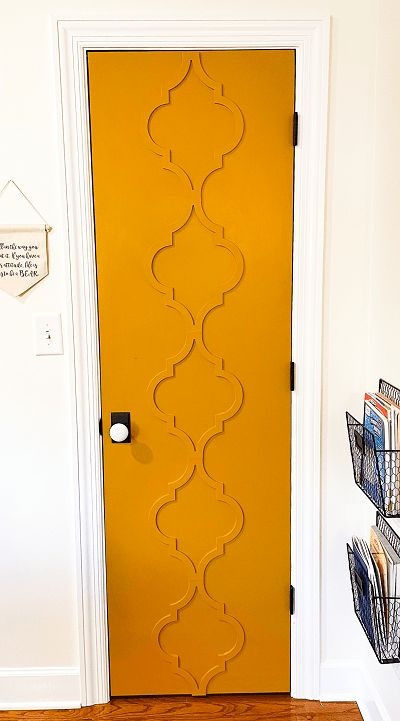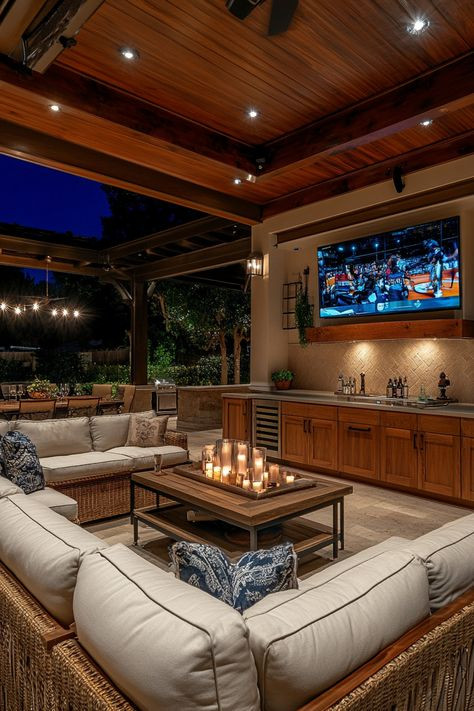Transforming Interior Spaces: The Bold Elegance of a Geometric Accent Door
In the ever-evolving world of interior design, sometimes it’s the smallest changes that make the most significant impact. One such underrated feature that holds the potential to dramatically alter the aesthetic of a room is the door. While many view doors as purely functional, they can serve as an unexpected canvas for creativity. The door in this image is a striking example—a bold mustard-yellow color combined with a symmetrical geometric overlay design creates a visually captivating piece that elevates the entire space.
This article explores the thought process, aesthetic value, design considerations, and broader implications of using a decorative door to redefine your interior space.
The Role of Color: Why Mustard Yellow Works
Color psychology plays a major role in interior design. Mustard yellow, as seen on this door, is a color that radiates warmth, optimism, and creativity. It's a color that commands attention without overwhelming the viewer. Unlike brighter yellows, which can feel overpowering or childish, mustard brings in a more mature, earthy tone that pairs beautifully with both neutral and bold palettes.
The mustard tone in this image contrasts beautifully with the white door trim and surrounding walls, creating a pop of color that feels intentional and refined. It adds a sense of vibrancy and energy to the space, which might otherwise feel minimalistic or stark.
A Study in Geometry: The Door’s Overlay Design
What truly makes this door a centerpiece is the geometric overlay that runs vertically down its center. This design resembles Moroccan or Moorish patterns, often found in Mediterranean or Middle Eastern architecture. Such patterns are not only decorative but also deeply symbolic, often reflecting themes of unity, infinity, and order.
The symmetrical repetition of this shape brings a sense of harmony and sophistication to the design. It adds depth to what would otherwise be a flat surface, casting soft shadows and catching light differently throughout the day. This detail subtly shifts the perception of the door from a functional object to a sculptural element.
Elevating a Functional Element into Art
Interior design is as much about storytelling as it is about function. The average interior door is overlooked, painted white, and expected to blend into the background. But this door proves that functional elements can become focal points. It invites the viewer to pause, admire, and even reconsider their own design choices.
By focusing on a single door, the designer has created an artful accent that doesn’t require a complete room overhaul. It's an example of how design doesn't always demand sweeping renovations—sometimes, a single piece can shift the entire ambiance of a space.
DIY Friendly or Designer Dream?
This kind of door can be achieved in multiple ways, depending on your budget and skill level. For DIY enthusiasts, the geometric overlay can be created using MDF cutouts or decorative wall panels adhered to a standard flat door. Once painted in a bold color, the entire piece transforms into a custom statement.
For those with access to bespoke carpentry or interior design services, a similar design can be professionally fabricated for a more refined finish. The key to success lies in the precise application of the overlay, smooth paint application, and thoughtful color coordination.
Where to Place a Statement Door
While this door could work virtually anywhere in a home, some locations lend themselves particularly well to accent doors:
Home Office: Add inspiration and creative energy to your workspace.
Pantry or Closet Doors: Turn overlooked spaces into stylish features.
Guest Room: Impress visitors with an unexpected touch of design.
Children’s Rooms: Encourage creativity and uniqueness in their space.
By selectively placing one or two statement doors in a home, you balance visual interest with cohesion.
Balancing the Space Around It
A bold feature like this door requires a supportive environment. In the image, the surrounding space is kept clean and minimal. The walls are white, the door frame is classic and neutral, and the adjacent accessories—like the wall-mounted file organizers and inspirational wall hanging—are subtle and functional.
This strategic simplicity ensures the door remains the focal point. Too much visual clutter around such a bold piece would dilute its impact.
If you're considering adding a statement door to your home, think about how the surrounding decor complements or contrasts with it. A good rule of thumb is to let the statement piece breathe.
Complementary Elements: Hardware and Trim
Another noteworthy detail in this design is the choice of door hardware. The matte black base with a white knob keeps the design contemporary and minimal, contrasting well with the bright yellow door. It's a perfect example of how even small hardware choices can significantly affect the final look.
The white trim around the door creates a strong frame, anchoring the color and pattern while tying into the rest of the room’s color scheme.
The Emotional Impact of Design
A beautifully designed space isn't just pleasing to the eye—it influences mood, mindset, and even productivity. A bold door like this can act as a daily source of inspiration. It breaks away from the mundane and dares to be different. It suggests that the home’s inhabitants value creativity, confidence, and individuality.
In a time when many people are rethinking their living spaces—whether due to remote work, minimalist trends, or a desire for personalization—adding character through small design statements can make a big emotional difference.
Final Thoughts: Why You Should Consider an Accent Door
A decorative door like the one pictured doesn’t just divide rooms; it connects design with emotion, color with function, and form with meaning. It's a prime example of thoughtful interior design—where form doesn’t just follow function but enhances it.
If you're looking to refresh your home without the disruption of a full remodel, consider starting with a single door. Choose a bold color, incorporate texture or pattern, and let it tell a story. As this example shows, a well-designed door can do more than close off a room—it can open the door to an entirely new way of experiencing your space.












